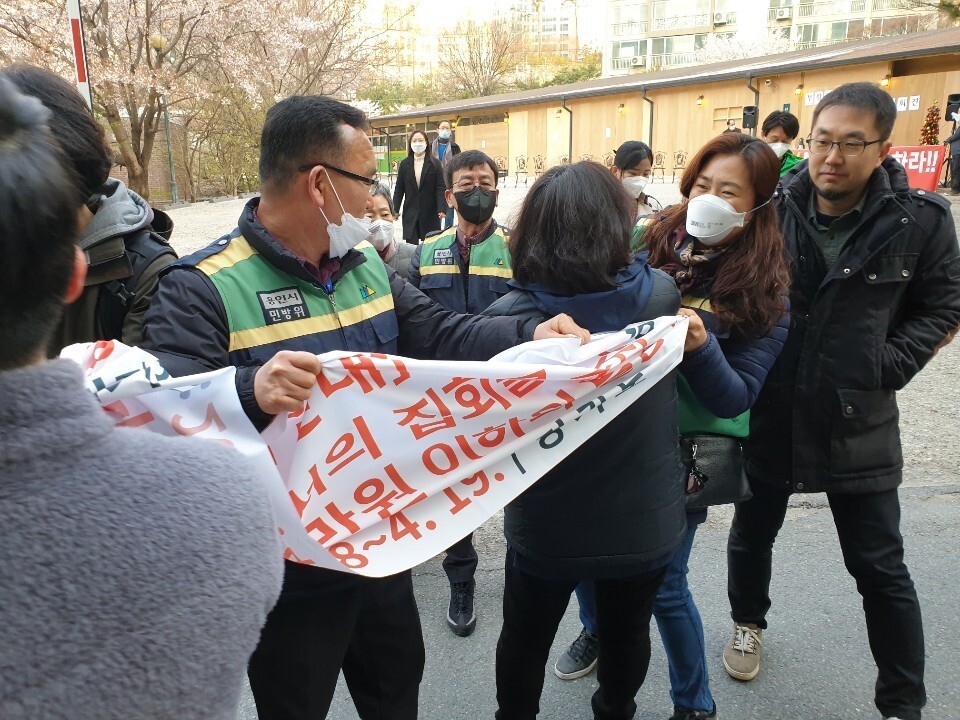hankyoreh
Links to other country sites 다른 나라 사이트 링크
Easter services and general election sparks concern over fresh surge of COVID-19 cases

While the number of new coronavirus cases in South Korea has fallen, the country’s disease control authorities are concerned that people who congregated at several large churches for Easter Sunday have undermined the government’s push for intense social distancing. For one thing, the occurrence of new cases must be stabilized before the country can switch to a more relaxed quarantine regime; for another, there needs to be widespread awareness that such a switch doesn’t mean it’s okay for large numbers of people to start gathering again.
South Korea’s Centers for Disease Control and Prevention (KCDC) reported 25 new cases of COVID-19 on Apr. 13 and 32 the previous day, putting the cumulative total at 10,537. This means that the country has seen fewer than 50 cases a day for the past week except for Apr. 8, when there were 53. There have also been 111 people who have tested positive for the disease after being released from quarantine following an apparent recovery.
While the rate of increase in new cases has slowed, in-person services held at certain churches this past weekend in defiance of government recommendations and the largest ever turnout for early voting in the parliamentary elections are making disease control authorities more nervous.
On Sunday, Easter mass was held online at all Catholic dioceses in the country, except for Jeju. A large number of Protestant churches also held their services online, while Onnuri Church in Seoul was one of several churches that held “drive-in services,” in which churchgoers stayed in their vehicles in the parking lot and listened to the service over the radio.
But there were also quite a few churches that held physical services streamed online, because of the religious significance of Easter. Four thousand people attended five services held at Myungsung Church in Seoul.
“Most of the people in attendance were ministers and senior members of the church, rather than ordinary members. We followed the disease prevention rules to the letter. Holding five separate services allowed us to maintain a distance of 2m distance between people in attendance, and we checked them for fever and ensured they were wearing masks,” a church spokesperson said.
A service at Kumnan Methodist Church was attended by 800 people who’d been cleared in advance, while Yoido Full Gospel Church also held five separate services that brought in some 900 people, most of whom were ministers and deacons.
“The disease control authorities are anxious about the fact that this past weekend saw the greatest increase in interpersonal contact over the past few weeks,” said KCDC Director Jung Eun-kyeong. Jung reiterated her call for South Koreans to “go back to the basics of COVID-19 prevention for the next week” and to “faithfully comply with social distancing and public behavioral guidelines.”

In an attempt to further prevent COVID-19 from entering the country from overseas, the disease control authorities will be requiring everyone arriving from the US to be tested for the disease, regardless of whether or not they have suspicious symptoms, starting Apr. 13. Previously, arrivals from the US had only been tested when they came down with symptoms during their two-week self-quarantine period, but now they’ll have to be tested within three days of entering the country, just like those arriving from Europe.
This measure was prompted by a surge in the number of COVID-19 cases occurring in people arriving from the US. Thus far, US arrivals account for 37.6% (343) of 912 confirmed cases imported from overseas. Focusing on the past two weeks, however, that percentage jumps to nearly half, or 49.7% (228 of 459). Arrivals from the US represented 18 of the 24 imported cases reported on Saturday.
By Kwon Ji-dam, Choi Ha-yan, and Chai Yoon-tae, staff reporters
Please direct comments or questions to [english@hani.co.kr]

Editorial・opinion
![[Column] Life on our Trisolaris [Column] Life on our Trisolaris](https://flexible.img.hani.co.kr/flexible/normal/500/300/imgdb/original/2024/0505/4817148682278544.jpg) [Column] Life on our Trisolaris
[Column] Life on our Trisolaris![[Editorial] Penalties for airing allegations against Korea’s first lady endanger free press [Editorial] Penalties for airing allegations against Korea’s first lady endanger free press](https://flexible.img.hani.co.kr/flexible/normal/500/300/imgdb/original/2024/0502/1817146398095106.jpg) [Editorial] Penalties for airing allegations against Korea’s first lady endanger free press
[Editorial] Penalties for airing allegations against Korea’s first lady endanger free press- [Editorial] Yoon must halt procurement of SM-3 interceptor missiles
- [Guest essay] Maybe Korea’s rapid population decline is an opportunity, not a crisis
- [Column] Can Yoon steer diplomacy with Russia, China back on track?
- [Column] Season 2 of special prosecutor probe may be coming to Korea soon
- [Column] Park Geun-hye déjà vu in Yoon Suk-yeol
- [Editorial] New weight of N. Korea’s nuclear threats makes dialogue all the more urgent
- [Guest essay] The real reason Korea’s new right wants to dub Rhee a founding father
- [Column] ‘Choson’: Is it time we start referring to N. Korea in its own terms?
Most viewed articles
- 1New sex-ed guidelines forbid teaching about homosexuality
- 2OECD upgrades Korea’s growth forecast from 2.2% to 2.6%
- 3[Column] Life on our Trisolaris
- 460% of young Koreans see no need to have kids after marriage
- 5Months and months of overdue wages are pushing migrant workers in Korea into debt
- 6[Guest essay] Maybe Korea’s rapid population decline is an opportunity, not a crisis
- 7Presidential office warns of veto in response to opposition passing special counsel probe act
- 8Is Japan about to snatch control of Line messenger from Korea’s Naver?
- 9Bills for Itaewon crush inquiry, special counsel probe into Marine’s death pass National Assembly
- 10Hybe-Ador dispute shines light on pervasive issues behind K-pop’s tidy facade